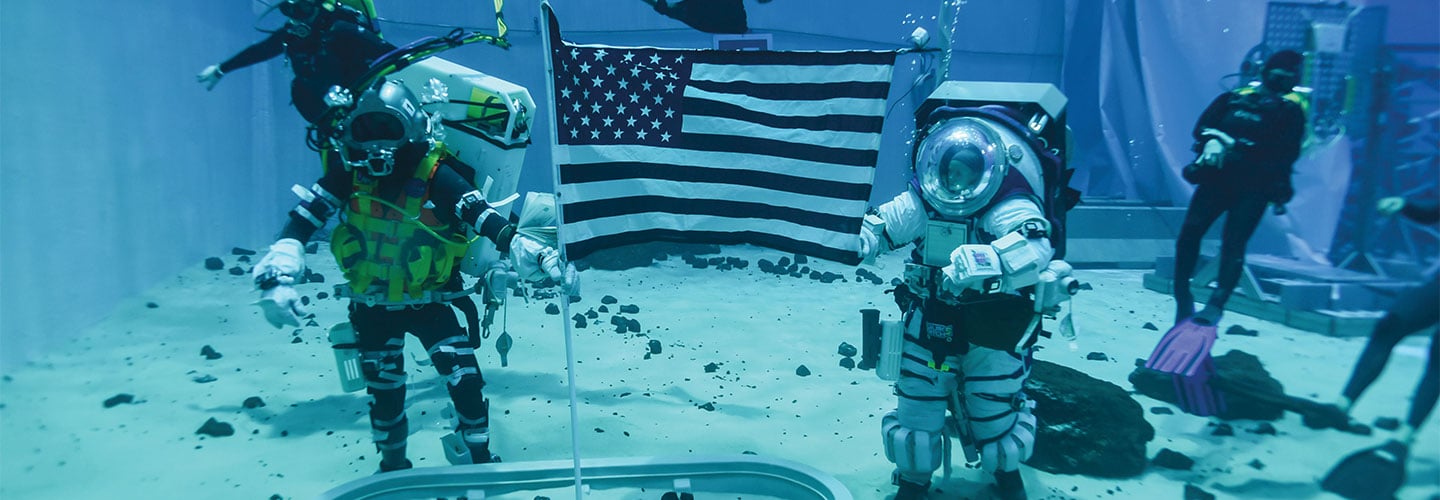You’re an astronaut walking across a desolate lunar landscape for the first time. With each step, your boots sink into the gritty surface underfoot. Even though you’re wearing a heavy spacesuit, you bounce forward in what seems like slow motion. That’s because the pull of the moon’s gravity is so weak. Or it would be . . . if you were actually on the moon. In reality, you’re on Earth at the bottom of a massive indoor pool.
This pool—12 meters (40 feet) deep and roughly the size of 10 Olympic swimming pools—is found at NASA’s Neutral Buoyancy Lab (NBL) in Houston, Texas. For the past 30 years, it’s been used to help train astronauts for space exploration. The surface of the water is good for practicing the recovery mission. That’s the final stage of spaceflight, when the capsule carrying crew members returns to Earth and splashes down into the ocean. Beneath the surface, the pool contains a replica of most of the International Space Station (ISS). Moving on and around this model, astronauts practice working in microgravity—the reduced pull of gravity that creates a sense of weightlessness in space. Most recently, NASA and an aerospace company called V2X have transformed the bottom of the pool into a realistic copy of the moon’s surface.
The simulation will be used as a training ground for NASA’s upcoming Artemis program. The astronauts flying this series of missions will include the first woman and person of color to visit the moon. It will mark humanity’s first return to the moon in more than half a century (see “Shooting for the Moon,” Science World, March 12, 2023). The crew will land near the moon’s south pole, an entirely unexplored region. There, they’ll encounter huge craters, extreme temperatures, and areas of permanent darkness. “It’s a fascinating and challenging environment to try to reproduce,” says Clay Tomlinson, a program manager at V2X.
You’re an astronaut on a barren lunar landscape. This is your first time walking across it. With each step, your boots sink into the gritty surface. You’re in a heavy spacesuit, but you bounce forward, like you’re in slow motion. That’s because the pull of the moon’s gravity is so weak. Or it would be . . . if you were actually on the moon. Really, you’re on Earth at the bottom of a massive indoor pool.
This pool is 12 meters (40 feet) deep and about the size of 10 Olympic swimming pools. It’s found at NASA’s Neutral Buoyancy Lab (NBL) in Houston, Texas. For the past 30 years, astronauts have used this pool to train for space exploration. The surface of the water is good for practicing the recovery mission. That’s the final stage of spaceflight, when crew members return to Earth. They ride inside a capsule that splashes down into the ocean. Under the surface, the pool contains a model of most of the International Space Station (ISS). Astronauts move on and around this model to practice working in microgravity. That’s the reduced pull of gravity in space. It creates a feeling of weightlessness. Recently, NASA worked with an aerospace company called V2X. They turned the bottom of the pool into a realistic copy of the moon’s surface.
The simulation will be a training ground for NASA’s upcoming Artemis program. This series of missions will include the first woman and first person of color to visit the moon. It will mark humanity’s first return to the moon in more than half a century (see “Shooting for the Moon,” Science World, March 12, 2023). The crew will land near the moon’s south pole. That’s an entirely unexplored region. They’ll come across huge craters, extreme temperatures, and areas of permanent darkness. “It’s a fascinating and challenging environment to try to reproduce,” says Clay Tomlinson, a program manager at V2X.

